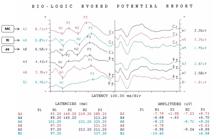ABSTRACT
Purpose
To analyze the latency and amplitude of P300 responses obtained with electrodes positioned at Cz and Fz and in different tasks of infrequent stimulus identification in normal hearing individuals.
Methods
Forty adults of both genders participated in the study. Three recordings with three different tasks were obtained for the identification of the infrequent stimulus; simultaneous recordings were obtained from Cz and Fz positions.
Results
Cz position showed significantly greater amplitudes and lower latencies than Fz. Regarding the three tasks, only “pronouncing the word ’thin’” was different from “raising a finger”, with lowest latencies for the verbal task. Regarding amplitude, significantly higher values were observed for “raising a finger”, followed by “pronouncing the word ‘thin’” and mental counting.
Conclusion
Cz obtained the best values, highest amplitude and lowest latency. Lowest latencies were obtained for the task of “pronouncing the word ‘thin’” and the highest amplitudes were obtained for “raising a finger”.
Keywords:
P300 Evoked Potentials; Young Adult; Hearing; Electrophysiology; Audiology

 Thumbnail
Thumbnail
 Caption: Cz = central position of the electrode at the central lobule; Fz = central position of the electrode at the frontal lobule; SD = standard deviation; MC = mental count; RI = raising the right index finger; PT = pronouncing the word “thin”; ms = milliseconds; µV = microvolts
Caption: Cz = central position of the electrode at the central lobule; Fz = central position of the electrode at the frontal lobule; SD = standard deviation; MC = mental count; RI = raising the right index finger; PT = pronouncing the word “thin”; ms = milliseconds; µV = microvolts